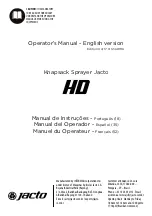
11
slightly warm to the touch while charging. This is
normal and does not indicate a problem.
•
Do not place the charger and battery pack in an
area of extreme heat or cold. They will work best
at normal room temperature.
NOTICE:
The charger and battery pack should be
placed in a location where the temperature is
more than 32
°
F but less than 100
°
F.
•
When batteries become fully charged, unplug the
charger from power supply and remove the
battery pack.
CHARGING A HOT BATTERY PACK
When using the tool continuously, the batteries in
the battery pack will become hot. You should let a
hot battery pack cool down for approximately 30
minutes before attempting to recharge. When the
battery pack becomes discharged and is hot, this will
cause the green LED to come on instead of the red
LED. After 30 minutes, reinsert the battery pack in
the charger. If the green LED continues to remain on,
return battery pack to your nearest Mokeneye
Authorized Service Center for checking or replacing.
NOTICE:
This situation only occurs when continuous
use of the tool causes the batteries to become hot. It
does not occur under normal circumstances. Refer to
"CHARGING A COOL BATTERY PACK"
for normal
recharging of batteries. If the charger does not
charge your battery pack under normal
circumstances, return both the battery pack and
charger to your nearest Mokeneye Authorized
Service Center for electrical check.
TO ATTACH/DETACH BATTERY PACK
See Fig. 15
Keep the trigger switch in the "OFF" position before
attaching or detaching the battery pack.
To attach the battery pack:
Align the raised rib on the battery pack with the
grooves in the tool, and then slide the battery pack
onto the tool.
To detach the battery pack:
Depress the battery-release button, located on the
front of the battery pack, to release the battery pack.
Pull the battery pack out and remove it from the tool.
NOTICE:
When placing the battery pack onto the
tool, be sure that the raised rib on the battery pack
aligns with the groove inside the tool and that the
latches snap into place properly. Improper
attachment of the battery pack can cause damage
to internal components.
TRIGGER SWITCH
See Fig. 16
Your tool is equipped with a variable-speed trigger
switch. The tool can be turned "ON" or "OFF" by
depressing or releasing the trigger.
•
Point the Spray Gun where desired, and squeeze
the Spray Gun Trigger to begin painting.
•
Release the Spray Gun Trigger to stop painting.
SPRAYING TECHNIQUE
•
Practice spraying on a piece of scrap material such
as cardboard to test your spray pattern and
become familiar with the flow control feature of
the sprayer.
•
Ensure surface to be sprayed is free of dust, dirt,
and grease.
•
Ensure spray area is clean and free of dust that
could be blown onto newly sprayed surfaces.
•
Cover any areas not intended to be sprayed.
•
Always spray from a minimum of 1 inch (25mm) to
a maximum of 14 inches (355mm)
(fig. 17)
.
•
A commonly used method for spraying a large
surface is the "crisscross" pattern. This is done by
spraying in horizontal strips and then crossing over
these strips with vertical strips.
•
To get an even spray distribution, always keep
your arm at the same distance
(fig. 17)
from the
surface you are spraying and avoid moving your
wrist
(fig. 18)
.
•
Maintain smooth and consistent speed which will
help avoid inconsistencies. Begin spraying after
the pass has begun and release trigger before
stopping the pass.
•
Avoid spraying too heavily in any one area. Several
lighter coats are better than one heavy coat which
can lead to running and dripping. Remember that
the flow control knob regulates the amount of
liquid that can be sprayed. Turning the flow knob
clockwise increases the flow of liquid. Turning the
knob counterclockwise decreases the flow of liquid.
If runs or drips do occur, have a dry paint brush on
hand to smooth them out.
•
Remove the battery pack from the sprayer when
not spraying for any length of time.
CLEANING
Be sure to use appropriate
protective gear.
•
Use drops cloths during pouring, mixing, and
viscosity testing of materials to be sprayed to
protect your floors and anything else in the
spraying area that you wish to remain untouched.
•
Do not use materials with a flashpoint higher than
60°C (140°F). Flashpoint is the temperature that a
fluid can produce enough vapors to ignite (see
coating supplier).
•
Make sure clean up area is well ventilated and free
of flammable vapors.
•
Always spray outdoors when spraying cleaning
solution through sprayer.
•
Do not submerse power unit.
TO BEGIN CLEANING:
•
Remove the Battery from the Spray Gun
•
Unscrew the Canister and pour the remaining
paint back into the paint can.
•
Thoroughly clean the Canister with the
appropriate thinner/cleaner (water or paint
































